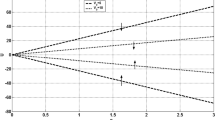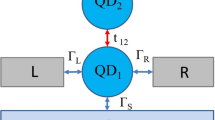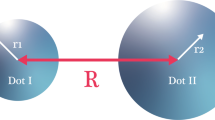Abstract
The main purpose of the present article is to report the characteristics of von Neumann entropy, thereby, the electronic hybrid entanglement, in the heterojunction of two semiconductors, with due attention to the Rashba and Dresselhaus spin-orbit interactions. To this end, we cast the von Neumann entropy in terms of spin polarization and compute its time evolution; with a vast span of applications. It is assumed that gate potentials are applied to the heterojunction, providing a two dimensional parabolic confining potential (forming an isotropic nanodot at the junction), as well as means of controlling the spin-orbit couplings. The spin degeneracy is also removed, even at electronic zero momentum, by the presence of an external magnetic field which, in turn, leads to the appearance of Landau states. We then proceed by computing the time evolution of the corresponding von Neumann entropy from a separable (spin-polarized) initial state. The von Neumann entropy, as we show, indicates that electronic hybrid entanglement does occur between spin and two-dimensional Landau levels. Our results also show that von Neumann entropy, as well as the degree of spin-orbit entanglement, periodically collapses and revives. The characteristics of such behavior; period, amplitude, etc., are shown to be determined from the controllable external agents. Moreover, it is demonstrated that the phenomenon of collapse-revivals’ in the behavior of von Neumann entropy, equivalently, electronic hybrid entanglement, is accompanied by plateaus (of great importance in quantum computation schemes) whose durations are, again, controlled by the external elements. Along these lines, we also make a comparison between effects of the two spin-orbit couplings on the entanglement (von Neumann entropy) characteristics. The finer details of the electronic hybrid entanglement, which may be easily verified through spin polarization measurements, are also accreted and discussed. The novel results of the present article, with potent applications in the field of quantum information processing, provide a deeper understanding of the electronic von Neumann entropy and hybrid entanglement that occurs in two-dimensional nanodots.
Similar content being viewed by others
References
J. Audretsch, Entangled Systems: New Directions in Quantum Physics (John Wiley & Sons, Germany, 2007)
W. Casteels, C. Ciuti, Phys. Rev. A 95, 013812 (2017)
Y.H. Su, A.M. Chen, C. Xiang, H. Wang, C.-J. Xia, J. Wang, J. Stat. Mech. 123102 (2016)
M. Salerno, V. Popkov, Phys. Rev. E 87, 022108 (2013)
S.S. Masood, A. Miller, Int. J. Eng. Sci. Innovative Technol. 4, 8 (2015)
T. Westermann, U. Manthe, J. Chem. Phys. 136, 204116 (2012)
L.J. Pereira, T.R. de Oliveira, Front. Phys. 4, 51 (2016)
R. Safaiee, M.M. Golshan, Eur. Phys. J. B 83, 457 (2011)
M.A. Nielson, I.L. Chuang, Quantum Computation and Quantum Information (Cambridge University Press, Cambridge, 2000)
W. Belzig, A. Bednorz, Phys. Status Solidi B 251, 1945 (2014)
R. Safaiee, F. Aghel, M.M. Golshan, J. Stat. Mech. 023101 (2016)
A.-B. Mohamed, H. Eleuch, Eur. Phys. J. D 69, 191 (2015)
M. Sahrai, B. Arzhang, D. Taherkhani, V. Tahmoorian Askari Boroojerdi, Physica E 67, 121 (2015)
C.H. Lin, Y.C. Lin, Y.K. Ho, Phys. Rev. A 87, 022316 (2013)
E. Räsänen, T. Blasi, M.F. Borunda, E.J. Heller, Phys. Rev. B 86, 205308 (2012)
A. Streltsov, Quantum Correlations Beyond Entanglement and Their Role in Quantum Information Theory (Springer, London, 2015)
G.B. Furman, V.M. Meerovich, V.L. Sokolovsky, Quantum Inf. Process. 8, 283 (2009)
R.F. Barbarona, F.N.C. Paraan, J. Stat. Mech. 053104 (2016)
B.K. Nikolić, L.P. Zârbo, S. Welack, Phys. Rev. B 72, 075335 (2005)
P. Busz, P. Rożek, D. Tomaszewski, J. Martinek, Acta Phys. Pol. A 127, 490 (2015)
F. Nichele, S. Hennel, P. Pietsch, W. Wegscheider, P. Stano, P. Jacquod, T. Ihn, K. Ensslin, Phys. Rev. Lett. 114, 206601 (2015)
J.M. Riley, F. Mazzola, M. Dendzik, M. Michiardi, T. Takayama, L. Bawden, C. Granerød, M. Leandersson, T. Balasubramanian, M. Hoesch, T.K. Kim, H. Takagi, W. Meevasana, Ph. Hofmann, M.S. Bahramy, J.W. Wells, P.D.C. King, Nat. Phys. 10, 835 (2014)
T. Otsuka, E. Abe, Y. Iye, S. Katsumoto, Phys. Rev. B 79, 195313 (2009)
J.T. Barreiro, T.C. Wei, P.G. Kwiat, Phys. Rev. Lett. 105, 030407 (2010)
C.X. Zhang, B. Guo, G.M. Cheng, J.J. Guo, R.H. Fan, Sci. China: Phys. Mech. Astron. 57, 2043 (2014)
X.L. Wang, X.D. Cai, Z.E. Su, M.C. Chen, D. Wu, L. Li, N.L. Liu, C.Y. Lu, J.W. Pan, Nature 518, 516 (2015)
R. Ionicioiu, A.E. Popescu, New J. Phys. 7, 120 (2005)
J.N. Ecksteina, J. Levy, MRS Bull. 38, 783 (2013)
R. Safaiee, N. Foroozani, M.M. Golshan, J. Stat. Mech. P02038 (2009)
G.M. Nikolopoulos, I. Jex, Quantum State Transfer and Network Engineering (Springer, Berlin, Heidelberg, London, 2014)
T.D. Ladd, F. Jelezko, R. Laflamme, Y. Nakamura, C. Monroe, J.L. O’Brien, Nature 464, 45 (2010)
C. Kloeffel, D. Loss, Annu. Rev. Condens. Matter Phys. 4, 51 (2013)
M. Leijnse, K. Flensberg, Phys. Rev. Lett. 107, 210502 (2011)
G. Chen, Z. Diao, J.U. Kim, A. Neogi, K. Urtekin, Z. Zhang, Int. J. Quantum Inf. 4, 233 (2006)
G. Burkard, D. Loss, Phys. Rev. Lett. 88, 047903 (2002)
H.R. Wei, F.G. Deng, Sci. Rep. 4, 7551 (2014)
J.M. Elzerman, R. Hanson, L.H.W. van Beveren, S. Tarucha, L.M.K. Vandersypen, L.P. Kouwenhoven, Lect. Notes Phys. 667, 25 (2005)
A.J. Leggett, B. Ruggiero, P. Silvestrini, Quantum Computing and Quantum Bits in Mesoscopic Systems (Kluwer Academic/Plenum Publishers, New York, 2004)
S. Bandyopadhyay, J. Atulasimha, Nanomagnetic and Spintronic Devices for Energy-Efficient Memory and Computing (John Wiley & Sons, United Kingdom, 2016)
R. Safaiee, F. Aghel, M.M. Golshan, Superlatt. Microstruct. 67, 221 (2014)
S. Zhang, R. Liang, E. Zhang, L. Zhang, Y. Liu, Phys. Rev. B 73, 155316 (2006)
S. Debald, C. Emary, Phys. Rev. Lett. 94, 226803 (2005)
It is worth mentioning that the effect of the two spin-orbit couplings, solely or together, has been studied extensively in different contexts. Reference [39] is resourceful in bibliographies regarding this subject. Also see, J. Capps, D.C. Marinescu, A. Manolescu, Phys. Rev. B 93, 085307 (2016)
W. Wang, J.Y. Fu, Physica B 482, 14 (2016)
T.C. Wei, K. Nemoto, P.M. Goldbart, P.G. Kwiat, W.J. Munro, F. Verstraete, Phys. Rev. A 67, 022110 (2003)
V. Vedral, M.B. Plenio, M.A. Rippin, P.L. Knight, Phys. Rev. Lett. 78, 2275 (1997)
S. Bandyopadhyay, M. Cahay, Introduction to Spintronics (CRC Press, Boca Raton, FL, 2008)
M. Trushin, Transport in low dimensional systems with spinorbit coupling (Ph.D. Thesis, University of Hamburg, 2005)
Y.A. Bychkov, E.I. Rashba, JETP Lett. 39, 78 (1984)
G. Dresselhaus, Phys. Rev. 100, 580 (1955)
J.J. Sakurai, Advanced Quantum Mechanics (Addison-Wesley, 1967)
S. Debald, Interaction and confinement in nanostructures: spin-orbit coupling and electron-phonon scattering (Ph.D. Thesis, University of Hamburg, 2005)
R. Safaiee, M.M. Golshan, Superlatt. Microstruct. 60, 540 (2013)
R. Safaiee, M.M. Golshan, N. Foroozani, J. Stat. Mech. P11014 (2009)
Author information
Authors and Affiliations
Corresponding author
Rights and permissions
About this article
Cite this article
Safaiee, R., Golshan, M.M. Von Neumann entropy in a Rashba-Dresselhaus nanodot; dynamical electronic spin-orbit entanglement. Eur. Phys. J. B 90, 121 (2017). https://doi.org/10.1140/epjb/e2017-70732-5
Received:
Revised:
Published:
DOI: https://doi.org/10.1140/epjb/e2017-70732-5




